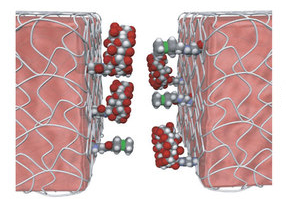Research Abstract
ホストポリマーとゲストポリマーから形成される酸化還元応答性自己修復材料
Redox-responsive self-healing materials formed from host–guest polymers
2011年10月25日 Nature Communications 2 : 511 doi: 10.1038/ncomms1521

現在、材料の長寿命化が強く望まれており、自ら回復・修復する材料は有益な物となる可能性がある。ホスト–ゲスト相互作用による超分子材料の形成は、従来にない材料を作り出す効果的な方法である。今回我々は、超分子ヒドロゲルの形成、酸化還元応答性、ホスト–ゲスト相互作用による自己修復特性について報告する。シクロデキストリン(CD)は環境にやさしく多様な用途があるため、我々はホスト分子としてCDを用いている。ホストポリマーとしてβ–CDを持つポリアクリル酸(pAA)と、ゲストポリマーとしてフェロセンを持つpAAとを混ぜ合わせると、透明な超分子ヒドロゲルがすばやく形成された。酸化還元刺激によって超分子ヒドロゲルのゾルゲル相転移が誘起され、切断面どうしの再接着といった自己修復特性を制御できた。
- 大阪大学大学院 理学研究科 高分子科学専攻
Expanding the useful lifespan of materials is becoming highly desirable, and self-healing and self-repairing materials may become valuable commodities. The formation of supramolecular materials through host–guest interactions is a powerful method to create non-conventional materials. Here we report the formation of supramolecular hydrogels and their redox-responsive and self-healing properties due to host–guest interactions. We employ cyclodextrin (CD) as a host molecule because it is environmentally benign and has diverse applications. A transparent supramolecular hydrogel quickly forms upon mixing poly(acrylic acid) (pAA) possessing β-CD as a host polymer with pAA possessing ferrocene as a guest polymer. Redox stimuli induce a sol−gel phase transition in the supramolecular hydrogel and can control self-healing properties such as re-adhesion between cut surfaces.

